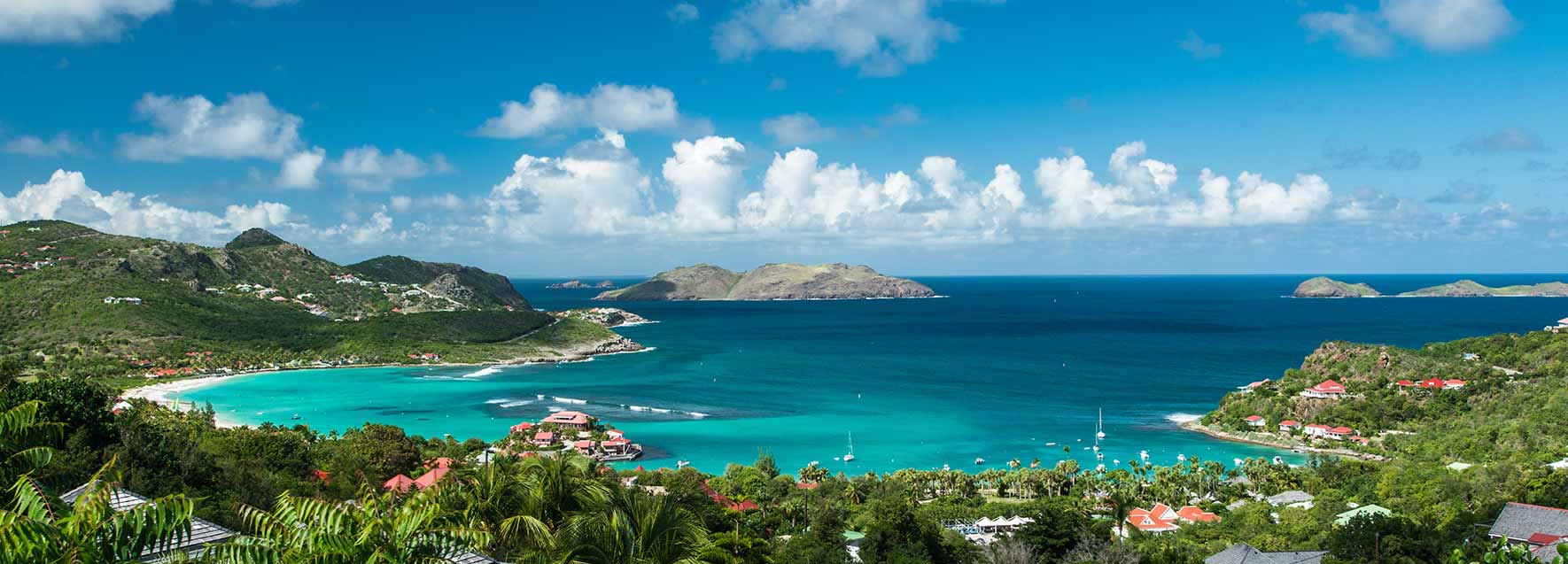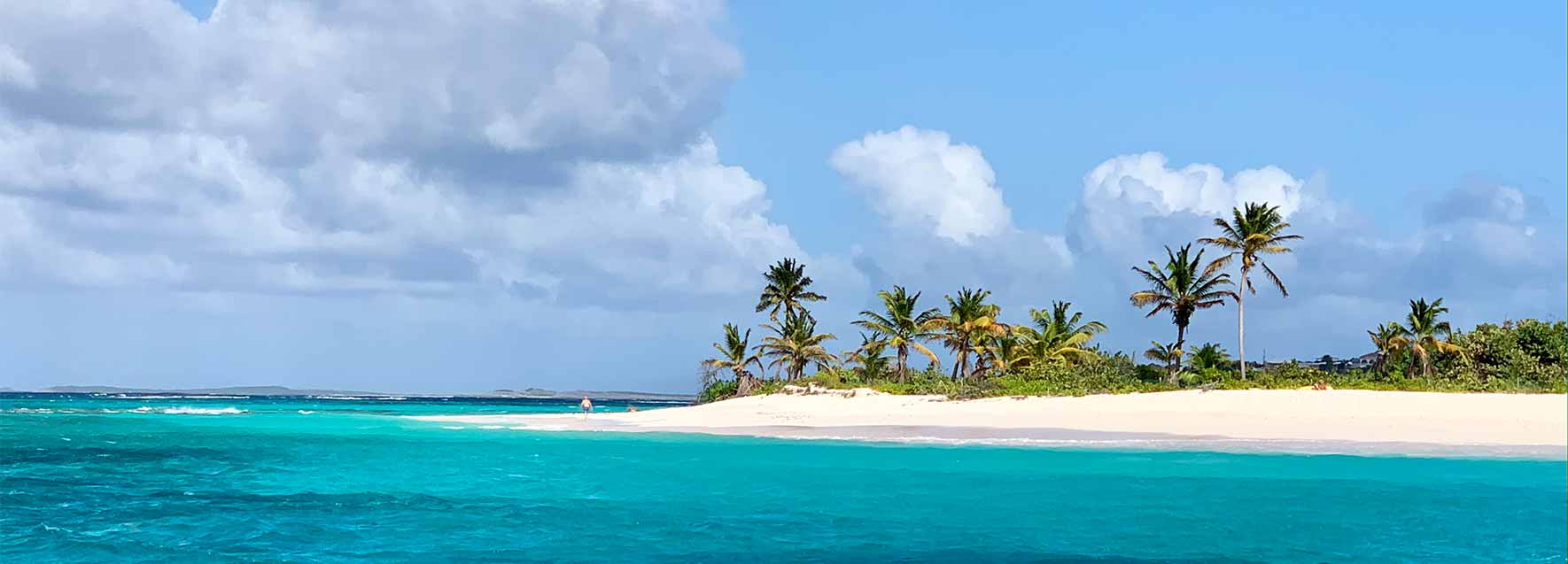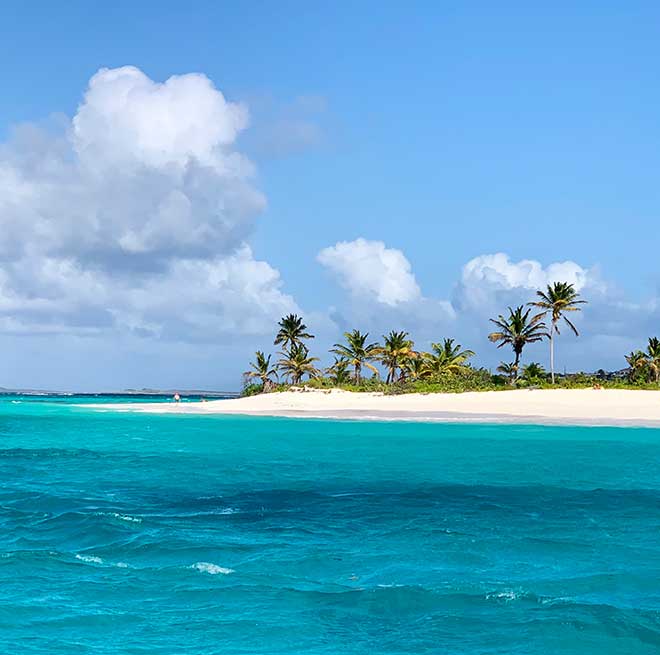Overview and history
It's a veritable multicolored cocktail that we suggest you savor on a catamaran cruise: shades of blue from the sea and sky, immaculate white and luminous blond from the fine sandy beaches, brilliant green from the palm trees, flamboyant colors from the luxuriant flora and exceptional marine fauna and the pastel hues of the facades of the Creole houses.
Your cruise will take you from Saint-Martin to Saint-Barthélemy, passing through the Anguilla archipelago, Anse Colombier, Sandy Island and Crocus. At the mere mention of these names, the first image that comes to mind is idleness on heavenly beaches, but this cruise has many other surprises in store for you, as you move from discovery to discovery under the warm Caribbean sun, cradled by the Caribbean Sea.
The best way to discover these pearls of the Antilles is, of course, by sea.
The various anchorages will take you on a journey through history: Fort Louis, built in 1750, or the old Creole huts and 19th-century facades of Marigot, the capital of Saint-Martin. But it's also a plunge into a protected natural environment exceptional for the variety of its fauna and the richness of its flora.
During your stopovers, you'll be able to observe turtles, coral, rays, lobsters, lambis, dolphins and pelicans, notably in the beautiful marine reserve of Saint-Barthélemy, but also magnificent landscapes made up of rare cacti, as on Ile Fourchue, palms, bougainvillea and hibiscus.
Your encounters with the island's uncommonly hospitable inhabitants, Caribbean evenings dancing zouk or salsa, or chatting in authentic seafarers' bars such as l'Oubli or le Select in Gustavia, or at Le Pirate or Chez Sissou in Grand Case, will punctuate your stay with friendly encounters.
Farniente, snorkeling in crystal-clear waters, water sports, sightseeing and hiking are all part of your cruise.
But this program wouldn't be complete without another must-do activity in this part of the West Indies: shopping! This tax-free shopping paradise will delight fans of French luxury brands (at the West Indies Shopping Mail in Saint-Martin), as well as madras or rum, leathers, fabrics and freshwater pearl jewelry in Grand Case, and the inevitable 'St Barth Attitude' or 'St Barth West Indies' t-shirts in Saint-Barthélemy.
The beauty and riches you'll discover on your Catlante Catamarans Cocktail d'îles Turquoises cruise between Saint-Martin, Saint-Barthélemy and Anguilla have been shaped by a turbulent colonial history.
Located in the Lesser Antilles archipelago some 255 km from Guadeloupe, Saint-Martin is an island with a surface area of 87 km2 divided into two states. The French part (located in the north of the island) has been an overseas collectivity since 2007. As for the southern part (called Sint-Maarten), it has been a fully-fledged state of the Kingdom of the Netherlands since 2010.
Known for its heavenly beaches (nearly thirty of them) and charming villages, Saint-Martin is also a free port.
Saint-Martin was discovered in 1493 by Christopher Columbus. From the 16th century onwards, freebooters and privateers from Spain, France, Holland, Portugal and England followed one another. In the 17th century, the French and Dutch signed a treaty officially dividing the island between them. This was the era of slavery, which did not come to an end until the 19th century, and of sugar production followed by cattle breeding, cotton, rum, tobacco and salt.
Partly devastated by hurricanes Luis in 1995 and Irma in 2017, the island of Saint-Martin has rebuilt itself to become the "Friendly Island" it is today, attracting thousands of visitors every year thanks to its beaches, festive nightlife, gastronomy and the formidable playground it offers sailing enthusiasts thanks to its proximity to Saint-Barthélemy and the Anguilla archipelago.
The Anguilla archipelago covers an area of 102 km2. It comprises a main island (from which it takes its name) and numerous islets and deserted islands. Anguilla is a British overseas territory and has been associated with the Organization of Eastern Caribbean States since 1995.
With over 30 km of white sandy beaches, Anguilla is renowned for its coral reef, turquoise waters and numerous bird species. It's a world-renowned diving spot for the beauty of its seabed and the countless aquatic species that live there.
The Arawak Indians nicknamed present-day Anguilla "the arrowhead" (Mallouhana) in 600 AD. It was Christopher Columbus who gave the island its current name of Anguilla in 1493, due to its eel-like shape.
A haven for privateers, the English colonized Anguilla in the 17th century, and planters began settling there with their slaves. It was the descendants of these slaves who bought back the land. It wasn't until 1982 that the Anguilla archipelago became a separate British territory.
Today, Anguilla's main source of income is tourism, which accounts for two-thirds of its GDP.
Another overseas collectivity since 2007, Saint-Barthélemy is a French island in the Lesser Antilles. Commonly known as Saint-Barth, the island covers an area of just 25 km2 and is a true paradise, so much so that its beaches frequently grace the pages of magazines to evoke beauty and luxury.
Discovered by Christopher Columbus in the 15th century, the French began occupying Saint-Barthélemy in the 17th century. After a brief period governed by the Knights of Malta and then ceded to the Swedes, it wasn't until 1878 that the French attached the island to Guadeloupe.
In the middle of the 20th century, Saint-Barth took on the face it has today: a mecca for upmarket tourism, fiercely preserved. A true tropical paradise, this destination attracts a wealthy clientele (rock stars, actors, businessmen) who find here a haven of peace away from the glare of the public eye.
Saint-Martin, the Anguilla archipelago, Saint-Barthélemy: a cocktail of turquoise islands to be enjoyed without moderation.


Comment s'y rendre
Reach Saint Martin easily
By plane
- From Paris: Air France (direct, arriving at Princess Juliana airport on the Dutch side) / Air Caraïbes (with a stopover at Pointe-à-pitre and arriving at Grand Case airport on the French side) (approx. 9hrs flight)
- From other major French cities: Air France with a stopover in Paris
- From Belgium: Air France from Brussels with a stopover in Paris (train+plane package)
- From Switzerland: Air France from Geneva with a stopover in Paris
- From Luxembourg: Luxair + Air France from Luxembourg with a stopover in Paris,
A savoir avant de partir
CATLANTE cruises depart from the Fort Louis marina in Marigot on the island of Saint Martin on Saturdays from November to April.
For EU nationals: passport must be valid for at least six months after the end of the cruise, for each participant. Authorization to leave the country for minors traveling without at least one parent or legal guardian.
Boarding takes place at the Fort-Louis marina in Marigot at 6pm. Disembarkation takes place in the morning of D+8 at 9am.
Cabs at Princess Juliana airport in St Martin: check that the vehicle has a cab plate on the roof, to avoid pirates.
Carry US dollars with you, as rates (around $30 for 2) will be the same in euros.
At Grand Case airport (flights from Guadeloupe): cab Jean Philippe 06 90 87 47 92 or 06 90 55 96 15 Call on behalf of Catlante. It's best to book when you board your regional flight.
Luggage storage at the Wine Bar, just opposite the pontoon entrance to Marigot's Fort Louis marina. €5 per bag, Saturday between 11am and 6pm.
Rent a car for a day in St Barth to discover the island.
In Saint-Martin, Anguilla and St Barth, the most widely used currency is the US dollar. Be sure to carry a few hundred in cash.
The climate in the West Indies is tropical, with the dry season running from mid-November to mid-May.
The official language is French in St-Martin and St Barth (English and Dutch in the Dutch part of the island) and English in Anguilla.

Enjoy your trip with CATLANTE Catamarans
The French leader
for 20 years
The tranquility
of the all-inclusive
A local and quality
cooking
French flag,
French-speaking crews
Eco-responsible
holidays

